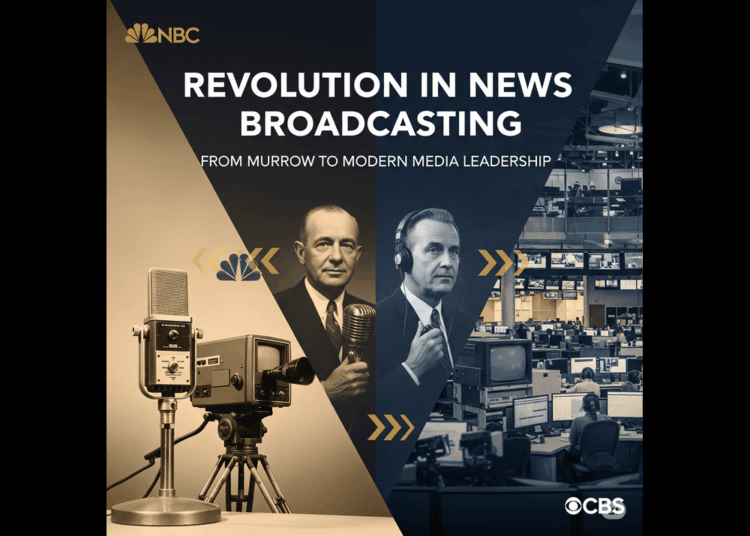Introduction: The Dawn of a Revolution in News Broadcasting
The Revolution in News Broadcasting reshaped journalism forever, transitioning it from print-dominated narratives to dynamic audio and visual storytelling. In this transformative era, Edward R. Murrow and Bob Edwards emerged as pioneering voices, challenging bureaucratic norms and driving innovation in journalism. The rise of major networks like NBC and CBS, coupled with the Birth of Broadcast Journalism, marked a turning point that redefined how societies consumed information.
Edward R. Murrow: The Voice of Integrity
No discussion on the Revolution in News Broadcasting is complete without Edward R. Murrow. Known for his uncompromising integrity and groundbreaking reporting, Murrow pioneered the use of live radio broadcasts during World War II.
-
From Radio to Television: Murrow’s transition from radio to CBS television reporting demonstrated his ability to adapt to emerging technologies. His program See It Now exposed societal issues, setting journalistic standards for decades.
-
Challenging Bureaucracy: Murrow famously confronted McCarthyism, challenging political bureaucracy and misinformation—a bold move that cemented his legacy as a defender of truth.
Through his leadership, Murrow elevated CBS to become a powerhouse in news reporting, influencing how newsrooms approached investigative journalism globally.
Bob Edwards and the Reinvention of Broadcast Journalism
Another influential figure in the Revolution in News Broadcasting, Bob Edwards, brought a fresh, calm demeanor to radio journalism. As a longtime host of Morning Edition on NPR, Edwards exemplified journalistic excellence by focusing on in-depth reporting and storytelling rather than sensationalism.
-
Disruption of Traditional Formats: Edwards reinvented radio broadcasting by blending news with thoughtful interviews, challenging fast-paced, headline-driven models.
-
Leadership in Newsrooms: Under Edwards’ guidance, radio became a trusted source of nuanced information, influencing both public radio and mainstream broadcast networks.
His leadership highlighted how innovation and reinvention could disrupt established practices without sacrificing journalistic integrity.
NBC, CBS, and the Birth of Broadcast Journalism
The Revolution in News Broadcasting was also fueled by the competitive rise of NBC and CBS, which pioneered modern television news.
-
NBC’s Leadership: NBC introduced live television news bulletins, creating a real-time connection with audiences that print media could not match. Its early innovations in visuals and field reporting changed audience expectations permanently.
-
CBS and Murrow’s Influence: CBS, with Murrow at the forefront, blended journalistic rigor with emerging broadcast technologies. The network’s documentaries and investigative reports set a gold standard for truth-driven news.
This rivalry between NBC and CBS drove innovation, leading to the Birth of Broadcast Journalism as a dominant force in shaping public opinion.
Reinvention and Disruption in Newsrooms
The journey of the Revolution in News Broadcasting is characterized by constant reinvention and disruption. From radio waves to digital platforms, newsrooms had to continuously evolve:
-
From Bureaucracy to Agility: Traditional newsroom bureaucracy slowed decision-making. Visionary leaders like Murrow dismantled these rigid structures, fostering responsive and investigative journalism.
-
Technological Evolution: Television brought live visuals, while later digital broadcasting and 24-hour news cycles disrupted old reporting models.
-
Changing Audience Expectations: Viewers demanded immediate, credible news, pushing networks to adopt new technologies and storytelling formats.
Disruption became the norm, compelling news organizations to innovate while maintaining editorial integrity.
Leadership’s Role in Shaping Broadcast Journalism
Behind every milestone in the Revolution in News Broadcasting were leaders who defied conventions:
-
Murrow’s Courage: Standing against political intimidation set an example of journalistic bravery.
-
Edwards’ Consistency: Providing steady, reliable reporting earned public trust amid an evolving media landscape.
-
Network Visionaries: NBC and CBS executives recognized the potential of radio and television, investing heavily in infrastructure and talent that birthed modern journalism.
These leaders demonstrated that broadcast journalism’s success hinged not only on technology but also on the courage to challenge norms and bureaucracy.
Legacy and Future of the Revolution in News Broadcasting
The foundations laid by Edward R. Murrow, Bob Edwards, NBC, and CBS continue to influence today’s newsrooms. Modern journalism faces digital disruption, social media dominance, and AI-driven reporting—but the principles of integrity, reinvention, and fearless leadership remain relevant.
The Revolution in News Broadcasting taught the industry that adapting to change while upholding journalistic values is essential for credibility and public trust. As emerging platforms reshape information delivery, lessons from the past will guide future newsroom leaders in navigating innovation without losing sight of ethics.











